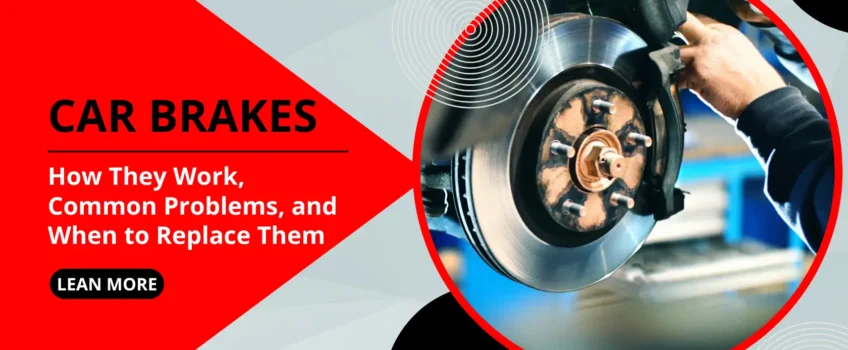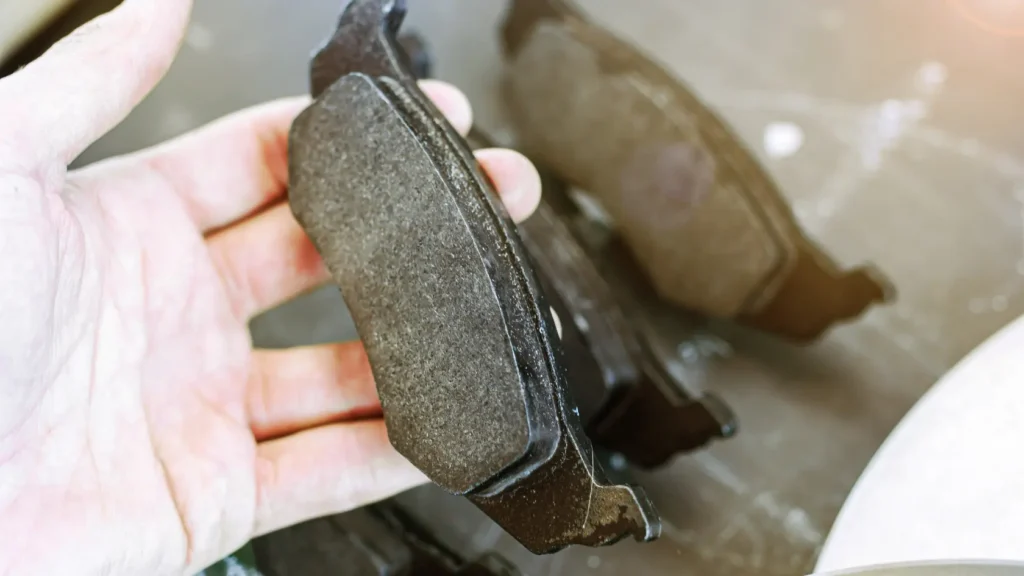
How Car Brakes Work, Common Problems, and When to Replace Them
Imagine driving down a familiar road when suddenly, you hear an unusual squeak from your car brakes every time you press the pedal. You shrug it off at first, but then you notice it takes longer to stop. Later, your child in the backseat asks, “Why does the car make that sound when you brake?” You realise it’s time to check your vehicle’s brakes before it gets worse.
The Importance of Maintaining Your Car Brakes
As any car owner should know, brakes are one of the most important safety components in any vehicle. Without properly functioning brake pads and brake discs, low brake fluid, or even a leak, stopping distances increase, and the risk of accidents is much higher. In this masterclass, we look closely at how your brakes work, common brake issues to watch for, and when it’s time for a brake replacement or repair.
How Do Car Brakes Work and Why Are They Essential?
When you press the brake pedal, a complex system springs into action. Brake fluid transfers pressure from the pedal to the brake pads, which press against the brake discs (also called rotors). This creates friction and in turn, slows down the car. The harder you press on the pedal, the more pressure is applied to the brake pads, resulting in a shorter stopping distance.
Modern vehicles use two main types of brakes:
- Disc Brakes are found in most modern cars and use brake pads that clamp onto brake discs to generate stopping power.
- Drum Brakes are Less common today and mostly in older cars. In this setup, brake shoes press against a drum inside the wheel.
Advanced Car Brakes: Driver Assistance Systems and Technology
Aside from providing safe braking capabilities, modern car brakes also have various features that make them more efficient and reliable. These include:
- ABS (Anti-lock Braking System) which helps prevent the wheels from locking up during emergency braking. This allows the driver to maintain better control of the vehicle.
- Brake Assist detects when a driver is making an emergency stop and applies maximum pressure to the brakes to decrease stopping distances.
- Electronic Brakeforce Distribution (EBD) automatically adjusts brake force between the front and rear wheels for optimal stopping power.
With these advanced systems in place, it’s clear that car brakes are essential for safety and for overall vehicle performance. That’s why it’s so important to understand common brake problems and know when it’s time to get new brakes for your car. Read this guide on ADAS (Advanced Driver Assistance Systems) and what such a service or calibration looks like.
How Do I Know My Car Brakes Need Attention?
Brakes are subjected to a lot of wear and tear over time, so you should keep an eye (and ear) out for any potential issues. Ignoring brake issues can lead to costly repairs or accidents. Here are some warning signs to look out for:
1. Squeaking, Squealing, or Grinding Noises
If your brakes are making high-pitched squeaks, it often means the brake pads are wearing down. Grinding sounds could indicate metal-on-metal contact, meaning the pads are completely worn out.
2. Soft or Spongy Brake Pedal
If your brake pedal feels unusually soft, there may be air in the brake lines or a brake fluid leak. Both issues require immediate attention.
3. Car Pulling to One Side When Braking
Uneven brake pad wear or a sticking calliper can cause your car to veer to one side when braking.
4. Vibrations When Braking
If your brake discs are warped, you may feel a shaking sensation through the steering wheel or brake pedal.
5. Dashboard Brake Warning Light
Many modern cars have a brake warning light that illuminates when there’s an issue with the brake system.
If you notice any of these issues, book a free brake check (visual only) at any of our Elite Garages branches. If it’s time for a brake repair or replacement, our car brake specialists will provide you with a no-obligation quote.
The Different Parts and Functions of Car Brakes

As mentioned earlier, brake pads and brake discs are the key components in a disc brake system. Understanding the key components of your car brakes can help you recognise problems early. Here is a short breakdown:
Brake Pads
These create the friction needed to slow down the car. Over time, they wear down and need replacing. Some have wear indicators that make a squealing sound when the pads are low.
Brake Discs (Rotors)
These metal discs rotate with the wheel. When the brake pads press against them, they generate stopping power. Like brake pads, they also wear down over time and may need to be replaced.
Brake Callipers
Callipers hold the brake pads and press them against the brake discs when you apply the brakes. They can become stuck or damaged, which affects braking performance.
Brake Fluid
This hydraulic fluid transfers the force from your brake pedal to the callipers. If it’s low, you may have a leak. It also needs to be changed periodically.
Brake Lines and Hoses
Brake lines carry brake fluid from the master cylinder to the brake callipers. Over time they can develop leaks or become clogged with debris, affecting brake pressure and response.
Handbrake (Parking Brake)
Used to keep the car stationary, especially on hills. In some cars, it uses a separate braking mechanism from the main brakes. This means you can use your handbrake to stop in emergency situations if the main brakes fail. However, it’s important to regularly check and maintain your handbrake, as any malfunctions can affect its performance and overall safety of your vehicle.
How Does An Electronic Handbrake Work?
An electronic handbrake, also called an electric parking brake, replaces the traditional handbrake lever with a push-button system. Instead of using a mechanical cable, it operates through small electric motors that apply pressure to the rear brake pads, holding the car in place.
The system can automatically engage when you turn off the engine and release when you start driving. Many models also feature a hill-hold function, preventing rollback on inclines. This innovation not only improves convenience but also enhances brake safety by ensuring a firm hold every time.
The Different Types of Car Brakes
Over the years, manufacturers have developed various types of brake pads, each with its own unique properties and benefits. Choosing the right brake pads can impact performance, durability, and braking efficiency. Here are the most common types of car brakes:
- Ceramic Brake Pads: Long-lasting, quiet, and produce less dust. Ideal for everyday driving.
- Semi-Metallic Brake Pads: Made of metal shavings combined with organic materials. Offer excellent stopping power but can be noisier and wear out the brake discs faster.
- Organic Brake Pads: Made from natural materials such as glass, rubber, and resins. They provide a smooth and quiet ride, but can wear out quickly and generate more brake dust.
- Performance Brake Pads: Used in high-performance or sports cars, these withstand extreme heat and stress.
- Low-Metallic NAO (Non-Asbestos Organic): These contain small amounts of metal, such as copper or steel, for increased brake performance. They can be noisy and produce more dust.
How Are Brake Pads and Brake Discs Made?
Ever wondered how brake pads and brake discs are manufactured? Here’s a brief overview of the process:
- Brake Pads: Brake pads are made from various materials, such as ceramic, semi-metallic, or organic compounds. The raw materials are mixed and formed into a block. Then, machines cut them into the desired shape and apply adhesives to attach any hardware.
- Brake Discs: Brake discs are usually made from cast iron or carbon-ceramic composites. First, a pattern is created for the disc using sand or liquid metal templates. Then molten metal is poured into the mould and allowed to solidify before it’s removed and machined to the correct dimensions.
Safety and Maintenance Tips for Car Brakes
To keep your car brakes in excellent condition, we highly recommend that you follow these essential brake maintenance tips:
- Check brake fluid regularly: Low fluid levels can reduce braking power.
- Inspect brake pads: If they’re thinner than 3mm, it’s time for a replacement.
- Avoid harsh braking: Sudden braking wears down your brake pads faster.
- Listen for unusual noises: Squeaks or grinding sounds indicate brake wear.
- Get a routine brake check: Regular inspections prevent costly repairs and ensure brake safety.
When to Consider Brake Repair or Replacement
The lifespan of car brakes varies depending on driving habits, conditions, and vehicle make/model. A general rule is that you should replace your brake pads every 30,000 – 70,000 miles (depending on factors mentioned above). Routine maintenance can extend the lifespan of your brakes, but sometimes, repairs or replacements are necessary. Here’s when to act:
- Brake Repair: If you have minor wear, such as uneven braking or a soft pedal, a mechanic may be able to resurface brake discs or top up brake fluid, maybe even replace the brake lines.
- Brake Replacement: When brake pads are worn past their limit, or brake discs are severely damaged, a full replacement is needed.
Recommended: Understanding Preventative Maintenance: A Guide For Every Car Owner
Masterclass Summary: Don’t Ignore Your Car Brakes
You started with a concern—a strange noise, a spongy pedal, or maybe just a gut feeling that something wasn’t right with your car brakes. Now, you know the signs of brake wear, the differences between brake pads and brake discs, and how to keep your braking system performing at its best.
Understanding your brakes means you’re no longer driving with uncertainty. Instead of worrying about potential issues, you can confidently take action when needed. Whether it’s booking a routine brake safety check, replacing worn-out brake pads, or getting a full brake repair, you now have the knowledge to make informed decisions.
So the next time you press the brake pedal, you can do so with confidence, knowing your car brakes are in top condition. And if you ever need expert guidance, the brake specialists at Elite Garages are here to help.
FAQS: Car Brakes and Maintenance
Click the + to read any answer or visit our most FAQ page to review the most frequently asked questions across all our Elite Locations.
If you click on a ‘Category’ or ‘Tag’ link, the page will ‘refresh’ and reload the page showing the top of the page first, you’ll then just need to scroll down to the FAQ section to see the results for the Category or Tag you selected.
The lifespan of your car brakes depends on several factors, including your driving habits, the quality of the brake components, and the type of driving you do. In general, however, you can expect your vehicle’s brake pads to last between 30,000 and 70,000 miles.
There are a few signs that can indicate you need new brakes, including squeaking or grinding noises when braking, a vibrating steering wheel and decreased responsiveness when engaging the brake pedal. If your vehicle is showing any of these signs, it’s important to have it looked at by a qualified technician.
While it’s technically possible to drive with brake problems, it’s not recommended and can be extremely dangerous to you and other road users. Driving with brake problems can result in reduced braking performance, uneven and increased wear on brake components.
About Us
Opening Times
Saturday : 8:30–4:00
Sunday : closed
More Information
Contact UsCustomer Information Pack
Check MOT Due Date
Free MOT reminder
Careers


